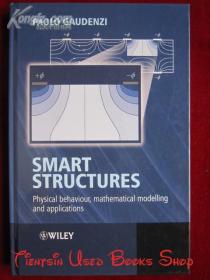
Smart Structures: Physical Behaviour, Mathematical Modelling and Applications(货号TJ)智能结构:物理行为、数学建模和应用
¥ 540 ¥ 144.5 九五品
仅1件
作者Paolo Gaudenzi
出版社Wiley
ISBN9780470059821
出版时间2009
版次1
印刷时间2009
印次1
装帧精装
开本23.8*16.2
纸张胶版纸
页数194页
定价144.5元
货号TJ0547-G261-c372
上书时间2022-07-10
- 在售商品 暂无
- 平均发货时间 2小时
- 好评率 暂无
- 最新上架
商品详情
- 品相描述:九五品
- 商品描述
-
本书为英语原版,精装本,原定价144.50美元,净重430克,馆藏。【图书分类:工业技术 > 一般工业技术 > 工程材料学 > 智能材料】Synthesizing knowledge acquired as a result of significant research and development over recent years, Smart Structures clearly illustrates why these structures are of such intense current interest. Gaudenzi offers valuable insight into both how they behave and how and at what cost they could be designed and produced for real life applications in cutting edge fields such as vibration control, shape morphing, structural health monitoring and energy transduction.
Smart Structures offers a basic and fundamental description of smart structures from the physical, mathematical and engineering viewpoint. It explains the basic physics relating to the behaviour of active materials, gives the mathematical background behind the phenomena, and provides tools for numerical simulation. It also offers an insight into considerations related to the manufacturing, assembly and integration of smart structures.
Smart Structures is divided into 5 sections: in the first part a definition of smart structures is proposed, the motivation for developing a smart structure presented and the basic physics of active materials such aspiezoelectrics, electrostrictives, magnetostrictives and shape memory alloys briefly recalled. A second part is devoted to the mathematical modelling of piezoelectric bodies. The third part discusses actuation and sensing mechanisms based on which the active part of a smart structure will produce “results” on the passive one. The fourth part deals with active composites at the micromechanical and macromechanical level, and the fifth part is devoted to applications of smart structures with examples taken from the aerospace field.
This introduction to smart structures will be useful both for structural and mechanical designers, and for students and researchers at graduate level or beyond. The diverse industries involved in this rapidly evolving field include aerospace, automotive and bioengineering.
Contents:
List of Figures.
Preface.
1 Introduction to Smart Structures.
1.1 Smart Structures and Traditional Structures: Definition and Main Constituents.
1.2 Smart Structures and Active Materials.
1.3 The Physical Behaviour of Active Materials for Actuation and Sensing.
1.4 Motivations for the Use of Smart Structure Technologies.
1.5 Monitoring Structural Integrity.
1.6 Shape Morphing.
1.7 Vibration Control.
1.8 Energy Harvesting.
References.
2 Mathematical Modelling of Piezoelectric Bodies.
2.1 Analysis of Piezoelectric Continua.
2.2 Finite Element Equations for Piezoelectric Problems.
2.3 Finite Element Simulation of Piezoelectric Analyses of Practical Interest.
2.4 Beam, Plate and Shell Models.
References.
3 Actuation and Sensing Mechanisms.
3.1 The Induced Strain Actuation Mechanism.
3.2 Axial Actuation.
3.3 Bending Actuation.
3.4 The Generalization of Pin-force and Euler–Bernoulli Beam Actuation.
3.5 Static Response of a Beam Subjected to Bending Actuation.
3.6 Dynamic Response of a Beam Actuated in Bending.
3.7 Higher Order Models for Beam Bending Actuation.
3.8 Sensing Mechanism.
3.9 Control Issues.
References.
4 Active Composites.
4.1 The Concept of Active Composites.
4.2 Piezoelectric Fibre Composites.
4.3 Interdigitated Electrodes for Piezoelectric Components.
4.4 Micromechanics of a Piezoelectric Fibre Composite.
4.5 Finite Element Evaluation of the Piezoelectric Properties of the Active Composite.
4.6 Macromechanics of Active Composites.
References.
5 Application of Smart Structures in Engineering Practice.
5.1 Shape Morphing.
5.2 Vibration Control.
5.3 Ultrasonic Motors.
References.
Index.
From the Back Cover:
Synthesizing knowledge acquired as a result of significant research and development over recent years, Smart Structures clearly illustrates why these structures are of such intense current interest. Gaudenzi offers valuable insight into both how they behave and how and at what cost they could be designed and produced for real life applications in cutting edge fields such as vibration control, shape morphing, structural health monitoring and energy transduction.
Smart Structures offers a basic and fundamental description of smart structures from the physical, mathematical and engineering viewpoint. It explains the basic physics relating to the behaviour of active materials, gives the mathematical background behind the phenomena, and provides tools for numerical simulation. It also offers an insight into considerations related to the manufacturing, assembly and integration of smart structures.
Smart Structures is divided into 5 sections: in the first part a definition of smart structures is proposed, the motivation for developing a smart structure presented and the basic physics of active materials such aspiezoelectrics, electrostrictives, magnetostrictives and shape memory alloys briefly recalled. A second part is devoted to the mathematical modelling of piezoelectric bodies. The third part discusses actuation and sensing mechanisms based on which the active part of a smart structure will produce “results” on the passive one. The fourth part deals with active composites at the micromechanical and macromechanical level, and the fifth part is devoted to applications of smart structures with examples taken from the aerospace field.
This introduction to smart structures will be useful both for structural and mechanical designers, and for students and researchers at graduate level or beyond. The diverse industries involved in this rapidly evolving field include aerospace, automotive and bioengineering.
-

【封面】
-

【封底】
-

【目录】
-

【内页】
-

【内页】
-

【插图】
— 没有更多了 —
















以下为对购买帮助不大的评价